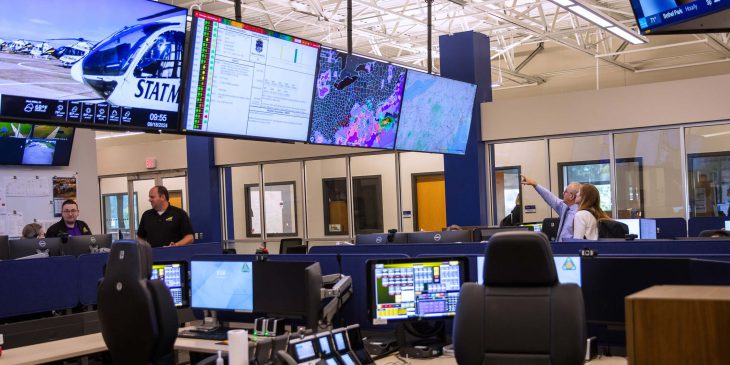It’s a familiar, if uncommon, scenario: You’re traveling on a commercial airplane when a member of the flight crew issues an announcement: “Ladies and gentlemen, we have a medical situation on board. If there are any medical professionals on the flight, please ring your call button.”
In the tense moments that follow, passengers look around anxiously and hope that someone comes forward to help. And in many cases, they do. But what you may not know is that there are people who provide critical medical consultation from the ground — not only advising treatment for the sick passenger or crew member, but also assisting pilots and dispatchers with the flight diversion process when necessary. And one of those in-flight medical consultation services, STAT-MD, is proudly staffed and operated by UPMC.

TJ Doyle
STAT-MD is a component of the Center for Emergency Medicine of Western Pennsylvania, a business unit of UPMC. Based out of a brand-new communications center in West Mifflin, Pa., STAT-MD staff consult on approximately 16,000 calls each year that come in from a range of commercial, corporate, and private air carriers.
We sat down with STAT-MD’s medical director, TJ Doyle, MD, MPH, to learn more about the unique role that he and his team play in emergencies that take place at 30,000 feet — a role that demands not only medical expertise but also quick thinking and decisive action. With stories that highlight both the tension and triumph inherent in in-flight emergencies, TJ sheds light on how STAT-MD has evolved over the years and the importance of collaboration between medical professionals and flight crews.
When and how did you first get involved with STAT-MD?
We’ll have to go all the way back to the year 2000. I came to UPMC Emergency Medicine as a fellow in Emergency Medical Services (EMS). As part of the fellowship, we did shifts in the communication center, which was [then] located on the top floor of UPMC Presbyterian.
As an EMS fellow, I got involved with all aspects of emergency medical services in Pittsburgh. In addition to working shifts in the communication center, we rode in response vehicles and worked as flight physicians for STAT MedEvac. I enjoyed working in the communication center and eventually became the medical director in 2013.
What kind of training do STAT-MD employees undergo?
For physicians, EMS fellows get about three months of training, including an orientation course and supervised shifts. Medical coordinators, who are not providers, have a different training process. They’re the ones who handle initial call intake before relaying information to the physician.
What are some challenges unique to providing medical consultations for commercial flights?
The primary challenge is that we can’t see or examine the patient. We have to make assessments and recommendations based on limited information. There are three possibilities: the issue resolves on its own, we use the emergency medical kit on board to stabilize the passenger, or we recommend the flight diverts to a location with medical facilities.
What can be found in the medical kit on board a typical commercial aircraft?
The Federal Aviation Administration (FAA) dictates a minimum amount of first-aid materials an airline must carry, though we have found that each airline’s kit is different. Commercial airlines have emergency oxygen and are required to carry an automated external defibrillator (AED). Most have intravenous equipment and emergency medications.
That said, most airlines do not have flight attendants who are qualified to provide emergency treatment, so we typically rely on coordinating with a medical volunteer on board. This is usually a physician, nurse, or EMT/paramedic.
What happens in the event that the medical situation is unresolved, and the flight has to divert?
The STAT-MD physician will share their medical recommendation with the flight crew, but ultimately the pilot makes the final decision on whether to divert. If diversion is needed, STAT-MD assists the airline in finding a suitable alternate destination based on where they are in the world, and what kind of resource the passenger might need. For example, the STAT-MD team can recommend that the airline land near a stroke center versus a community hospital.
Can you describe a particularly memorable call you’ve handled at STAT-MD?
One memorable call was a transpacific flight where a pregnant woman was experiencing intense pain. Initially, I was told she was eight weeks pregnant, so I was imparting medical advice with this assumption. The situation was challenging because the flight was in the “no man’s land” over the Pacific Ocean, past Alaska.
The woman’s condition was worsening, but there was not much we could do in terms of recommending diversion, so my goal was to keep her comfortable with pain medication. When the flight crew called us back, they announced that they’d just delivered a baby: they were able to find medical volunteers to help, and the umbilical cord had been cut. It turns out the whole thing was a miscommunication from the beginning; the woman was 38 — not eight — weeks pregnant. Fortunately, a healthy baby was born in the sky somewhere north of Japan.
Miscommunications like that are rare, and “memorable” for the same reason. STAT-MD receives about 40 calls each day, so we’ve had plenty of other high-stakes situations that resulted in happy endings. For example, another memorable case involved a sudden cardiac arrest. We were able to coach the flight crew through administering CPR and AED shocks on the patient. Meanwhile, the airline captain decided to divert the flight, allowing us to recommend a nearby hospital. Immediately upon landing, an ambulance was waiting to rush the patient to the hospital. We learned later that the patient ultimately made a full recovery.
Another memorable case, because it was so unusual, was one involving a canine passenger. The dog was in distress, and we advised the crew to put the dog on oxygen. As far as I know, the dog made a full recovery too.
What are some of the most common medical issues addressed by STAT-MD?
Many of the calls we receive are related to fainting events, respiratory/oxygen issues, nausea and GI issues, chest pain, and the like.
But a lesser-known service that STAT-MD provides is pre-flight, or “fitness to fly,” evaluations. In these scenarios, we are consulting with airline staff on the ground on whether or not it is safe for a particular passenger to get on the airplane. This situation is often prompted when a passenger verbalizes something to the gate agent that concerns them, or the passenger shows up to the gate with an oxygen tank — it’s against FAA regulations to bring an oxygen tank on an aircraft.
And plenty of injuries occur at the airport or on a grounded aircraft, which we also consult on. You may be surprised how many people get hurt on moving sidewalks and escalators in airports. It’s also not uncommon for people to sustain injuries while moving luggage in or out of a plane’s overhead bins.
We know that a medical condition that a passenger or crew member has on the ground is only going to be exacerbated at altitude. We want to stop them from having the medical emergency on board.
What do you wish more people knew about the work that STAT-MD does?
I wish more people knew that there are companies providing ground-based medical support for in-flight emergencies. Medical volunteers on flights should know that they have support and don’t need to handle everything on their own. Also, if you’re sick, don’t fly — nothing gets better at altitude.
What motivates you to work in such a high-stakes and fast-paced environment?
I enjoy the unique challenges and variability. We get calls from all over the world, and it’s always interesting. The work is rewarding, especially when we can make a significant difference in a patient’s outcome.









